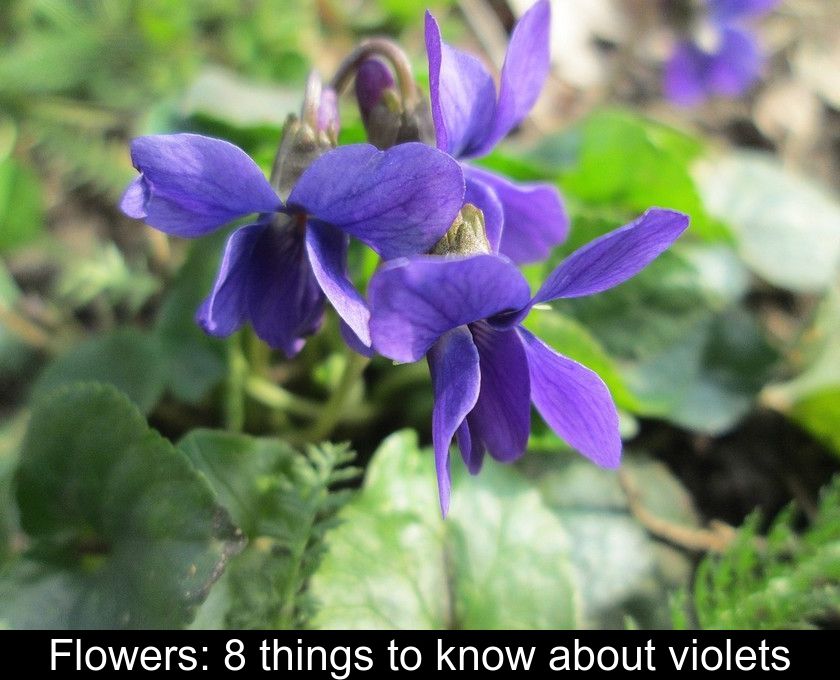Flowers: 8 Things To Know About Violets
Violets brighten up the beginning of spring with their sweet perfume. This small bewitching flower, whose Latin name is Viola odorata, is the emblem of the city of Toulouse. Not only does the violet perfume gardens and undergrowth, but it also has many uses in phytotherapy, perfumery and cooking. Here are 8 things you may not know about this flower.
1- Violets belong to the same family as pansies
Violets are herbaceous perennials in the same family as pansies, the genus Viola. Different horticultural varieties of Viola odorata are referred to as violet.
Many varieties of flowers in this family have been bred by humans, including the famous Violette of Toulouse.
The Flower emblematic of this city belongs to the Parma violet family, flowers that can have up to sixty petals!
2- The violet is common in Europe
The Violet is a rather common flower in France, as it thrives in neutral or chalky soil that is fairly humusy and well-drained.
It is found on all continents and is very common in Northern Europe of the plains and in Southern Europe of the middle mountains.
The Violet blooms in Spring for most species and in Autumn under certain climatic conditions, including alternating cold nights and sunny days.
3- It has three modes of reproduction
In the wild, it is not uncommon to find carpets of violets. This small flower tends to swarm and form patches of color in the undergrowth as it reseeds or reproduces by runners.
The violet can reproduce in three different ways:
- either by conventional pollination of its flowers
- or by emitting a stolon that will create a new plant
- or by producing capsules of Seeds by self-pollination.
4- The traditional cultivation of violets requires a lot of work
The traditional cultivation of violets is demanding as it is very labor intensive.
The cultivation cycle for violets spans a year and a half. Planting takes place in April-May and then the violets are watered and weeded manually throughout the summer.
In July, the violets are mowed so that the plant can rest and get through the hot weather. The mowing allowed in the past an additional supply of leaves for the perfume industry.
The harvest takes place from October to March and the flowers damaged or stemmed during this stage are reserved for the crystallization industry.
5- The violet has become inseparable from Toulouse
Originally, the Toulouse Violet was grown in a small area north of the city. Six communes (Lalande, Launaguet, Aucamville, Castelginest, Saint Jory and Saint Alban) are involved in this activity.
In 1936, Etablissements Berdoues created the Parfum 'Violettes de Toulouse' and in 1950, Mr Serres created the Violette liqueur.
These Toulouse companies still exist today and ship their products around the world.
6- The violet is also the emblematic flower of Tourrettes-sur-Loup
The village of Tourrettes-sur-Loup in the Alpes Maritimes is the only commune in France where violets are grown as a single crop and have been since 1880.
Around 1875, different varieties, including the Parma violet, were grown in the Grasse area. Today, only the Victoria variety is grown in Tourrettes-sur-Loup.
Since 1952, the commune has dedicated an annual festival to this Flower on the first or second Sunday in March. This year, the Festival of Violets of Tourrettes-sur-Loup is held on March 4 and 5, 2023, with its flower parade and many activities punctuating this great weekend of celebration!
7- The violet has multiple uses
The fragrant violet is used in confectionery, where Bonbons are made from fresh flowers crystallized in sugar. Violets crystallized in sugar, which are a specialty of Toulouse, have existed since the 19th century.
Perfumery also uses violets for their bewitching and suave Parfum... to which some lend an aphrodisiac power!
This plant was once recommended to treat headaches, insomnia and melancholy. Today, phytotherapy mainly uses these flowers in infusion (4 to 5 g for 20 cl of water) to treat diseases of the respiratory tract. Indeed, violet has emollient and expectorant properties.
8- It has several meanings in the language of flowers
Violets are sometimes called Trinity herbs. They were used as a rallying sign for the Bonapartists during the Hundred Days.
In the language of flowers, the violet symbolizes modesty and modesty, by allusion to the little corolla that seems reluctant to Step out of its leafy casket.
When blue, it expresses loyalty, while the white variety evokes Happiness in the countryside.
Violet is also a feminine name. Like all floral names, it is celebrated on October 5, Saint Flower's Day.









